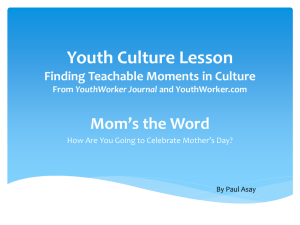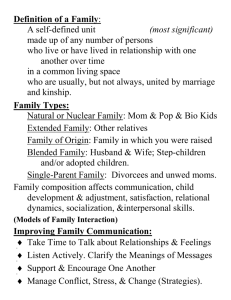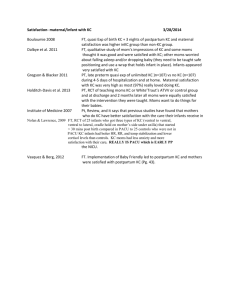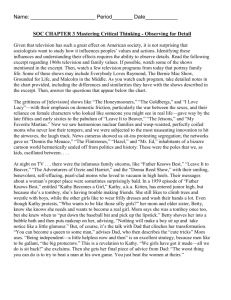Women's Rights
advertisement
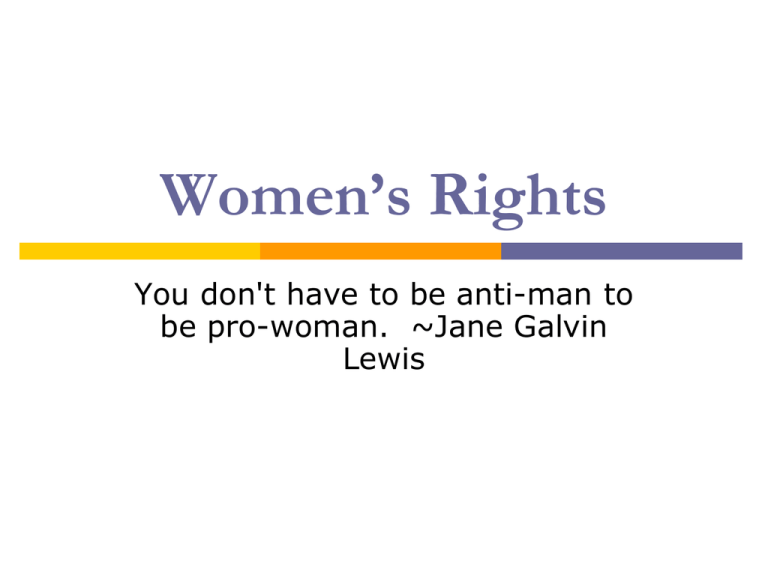
Women’s Rights You don't have to be anti-man to be pro-woman. ~Jane Galvin Lewis The emotional, sexual, and psychological stereotyping of females begins when the doctor says, "It's a girl." ~Shirley Chisholm It was we, the people; not we, the white male citizens; nor yet we, the male citizens; but we, the whole people, who formed the Union.... Men, their rights and nothing more; women, their rights and nothing less. ~Susan B. Anthony I've yet to be on a campus where most women weren't worrying about some aspect of combining marriage, children, and a career. I've yet to find one where many men were worrying about the same thing. ~Gloria Steinem How good does a female athlete have to be before we just call her an athlete? ~Author Unknown History and Women’s Movements in the United States First Wave (1840-1925) 1848 First Women’s Rights Convention: Seneca Falls Convention, New York August 26, 1920 19th Amendment: Granting women the right to vote Second Wave (1960-1995) Radical Feminism: Women’s Liberation Movement Reproductive Rights Myth of the feminists burned bras in 1968 to protest the Miss America pageant Continued The Guerilla Girls Betty Friedan The Feminine Mystique 1972 Equal Rights Amendment (ERA) and Title lX Sisters of ‘77 Create a national plan of action towards gender equality, which would then be given to the president and Congress. The Equal Rights Amendment Equality of the rights under the law shall not be denied or abridged by the United States or by any State on account of sex Section 2: The Congress shall have the power to enforce, by appropriate legislation, the provisions of this article. Section 3: This amendment shall take effect two years after the date of ratification. States Yet to Ratify the ERA In order for the ERA to pass, it had to be ratified by 38 states. Indiana was the 35th and final state to ratify the amendment in 1977. As of March 2005, 15 U.S. states have not ratified the ERA: Alabama Arizona Arkansas Florida Georgia Illinois Louisiana Mississippi Missouri Nevada N.Carolina Oklahoma South Carolina Utah Virginia Third Wave (1990’s) Women of different ethnicities, abilities and disabilities, classes, appearances, and sexual orientations Title IX of the Education Amendments of 1972 in 2002 the Patsy T. Mink Equal Opportunity in Education Act in honor of its principal author United States law enacted on June 23, 1972. The law states: "No person in the United States shall, on the basis of sex, be excluded from participation in, be denied the benefits of, or be subjected to discrimination under any education program or activity receiving Federal financial assistance..."[1] Although the most prominent aspect of Title IX is its impact on high school and collegiate athletics, the original statute made no explicit mention of athletics.[2] Women in the Workplace Glass Walls & Glass Ceilings Gender Stereotypes in the Workplace Women Sex Object Mother Child Iron Maiden Men Sturdy Fighter Bread- winner Oak Sex Object Judging based on appearance and actions Sexual harassment Mother Have or plan to have children perceived as “not serious professionals” “Emotional labor” Smile, listen, support, help others Child Not taken seriously Less mature Less competent / capable “Protecting” women Combat Iron Maiden Independent Ambitious Competitive Tough Gendered Wages Equal Pay Act of 1963 59 cents for every dollar men earned 2000, 72 cents 2004 80 cents Mothers still paid less than then woman who do not have children Obama signs Equal Pay Bill January 29, 2009 Easier for workers to sue for discrimination on the job Lilly Ledbetter Fair Pay Act Extends the period an employee can file a claim of discrimination for making less money than another worker doing the same job “That there are no second class citizens in our workplaces, and that it’s not just unfair and illegal—but bad for business—to pay someone less because of their gender, age, race, ethnicity, religion or disability” The bill is named for a woman who said she didn’t become aware of a pay discrepancy until she neared the end of her career at a plant owned by Ohio- based Goodyear Tire & Rubber Co Mean Weekly Salary: Men / Women Physician $1,364 Attorney $1,340 College Fac. $1,038 Bus Driver $498 Cook $340 $852 $974 $859 $384 $300 Weekly earnings of full time working women were about ¾ of men’s during 2001 (study of earnings history of over 9,300 Americans for over 18 years) Even accounting for factors such as occupation, industry, race, marital status and job tenure, working women today earn an average of 80 cents for every dollar earned by male counterparts Women are less likely to work a full time schedule and are more likely to leave the labor force for longer periods of time than men, further suppressing women’s wages Working women are penalized for their dual roles as wage earners and those who disproportionately care for home and family Men with children get an earnings boost, women lose earnings Men with children earn about 2% more on average than men without children Women earn 2.5% less than women without children Women’s median earnings: $638 a week Men’s: $798 (Department of Labor) Impact of wage gap is painful during our current economics downturn as families struggle to make ends meet in face of wages and job losses Pay gap does not necessarily indicate discrimination “Employers pay workers who have taken time out of the work force less than those with more experience on the job, and many women work less for family reasons” Hudson Institute Differences between Salaries of Male Faculty and Female Faculty 2005, The Chronicle of Higher Education: Highest faculty rank to the lowest across all 4-year institutions Prof. $94,235 $82,874 Ass. Prof $66,291 $61,539 Lecturer $47,008 $42,584 The Bill for Mom’s Services What would be charged for all of the things typical full-time mothers do? According to Newsweek (“Mother Matters,” 2005), the bill would come to $131,471.00 per year! Cost to hire: cleaning, day care, cooking, nursing, laundry, counseling, chauffeuring, and so forth If paid, Stay at Home Moms would earn $134,121 annually (up from 2005's salary of $131,471). Working Moms would earn $85,876 annually for the "mom job" portion of their work, in addition to their actual "work job" salary. Salary.com found the job titles that best matched a mom's definition of her work to be (in order of hours spent per week): housekeeper, day care center teacher, cook, computer operator, laundry machine operator, janitor, facilities manager, van driver, CEO and psychologist. New job titles that made the list in 2006 include psychologist, laundry machine operator, computer operator, and facilities manager. The job title of nurse fell out of the top 10 this year. "We don't want to add fuel to the mommy-war fire," said Meredith Hanrahan, senior vice president of Salary.com Interactive. "Both moms struggle with keeping the house clean and moms of both types reported making tremendous sacrifices to make their children happy, healthy, and successful. Stay at Home Moms give up the benefits of working outside the home, including extra income, title, and career advancement. Working Moms give up more sleep, time for exercise, and skip lunch to spend quality time nurturing and educating their children. In the end, both claim it was well worth it." Moms work an average of 90 hours a week Working Moms reported spending 44 hours per week at their "work job" and 49.8 hours at their "mom job," for a total of 93.8 hours per week. The Stay-atHome Mom works 91.6 hours at her mom job. Working Moms get less sleep Working Moms reported getting only 6.4 hours of sleep per night, versus 6.7 for the Stay-at-Home Moms. Working Moms work 7.2 hours as housekeeper, versus 22.1 for Stay at Home Moms Taken together, the three lowest paying roles of housekeeper, laundry machine operator, and janitor represent 29 percent of the Working Mom's "mom job," but as much as 38 percent of the Stay-at-Home Mom's job, suggesting that Working Moms need assistance with these tasks. "My house isn't as clean as I would like and I want to spend more time with my family" Working Moms and Stay at Home Moms both spend roughly 4 hours per week nurturing the emotional needs of their kids in the "mom job" of psychologist. The big difference appears to be in the "mom job" of day care center teacher, with Stay at Home Moms reporting an average of 15.7 hours per week and Working Moms reporting 7.2 hours per week Approx. 105,000 married American fathers choose to be “stay-at-home” dads- care for about 189,000 children under the age of 15 2 million American preschool children are cared for by their fathers more hours than by any other child care provider while their mothers are at work Number of single fathers has grown to 2 million, up from 393,000 in 1970 Women in Education Clearly, women have made great strides over the last two decades in their pursuit of college diplomas. Indeed, women account for 56 percent of college enrollment in the country, according to the U.S. Department of Education. And studies have shown that women are more likely than men to earn bachelor’s degrees – in every state, every income bracket and every racial group. Women earn 57 percent of all bachelor’s and 58 percent of all master’s degrees. Still, women are clearly underrepresented in science and engineering higher education programs – as well as in MBA programs. Women are earning from one-third to half of the science and engineering undergraduate and graduate degrees and an astonishingly low 30 percent of the MBAs that are being awarded. Sex Stereotypes affects selfconfidence Example: Math and Science Price Waterhouse vs Hopkins In 1989, the U.S. Supreme Court held in Price Waterhouse v. Hopkins that Title VII – the main federal anti-discrimination statute -- prohibits employers from penalizing employees for failing to conform to the gender stereotypes associated with their sex. Yet, two decades later, courts continue to show ambivalence in sex-stereotyping cases. More specifically, courts continue to uphold employers' dress and grooming policies that differentiate by sex and, in the course of doing so, demand that their employees adhere to the stereotypical appearance standards assigned to their sex. A recent federal court ruling, in Creed v. Family Express Corporation, involving a transsexual employee, illustrates – and repeats – the mistake of many other courts that have refused to see these policies as a form of illegal sex-stereotyping. In Price Waterhouse, the plaintiff, Ann Hopkins, was denied partnership in an accounting firm, at least in part because she was too aggressive, cursed like a truck driver, and did not walk, talk, or dress in a feminine manner. In short, she was a woman who acted like a man, and for that, she was dealt a career-stunting blow. Ruling on Hopkins's sex discrimination lawsuit, the Court held that Title VII forbids employers from discriminating against an employee for failing to live up to gender role expectations. You can't, in other words, punish a female employee for not being feminine enough. That sort of gender policing, the Court ruled, violates Title VII. In an oft-quoted line, the majority observed that: "[W]e are beyond the day when an employer could evaluate employees by assuming or insisting that they matched the stereotype associate with their group." How far does this reasoning reach? Ideally, it would reach as far as necessary to serve one of the central aims of antidiscrimination law: to promote equal employment opportunity through the eradication of sex-stereotyped decision-making. The reach of Price Waterhouse has been tested primarily in three types of cases: (i) cases of gay men or lesbians challenging harassment or other discriminatory behavior; (ii) cases of women challenging sex-differentiated dress or grooming codes; and (iii) cases of transsexuals challenging all varieties of employment policies and decisions. Cases in each category, as well as cases that involve intersecting categories, reveal both the limits and the untested waters of the law's protection against sex stereotyping. To begin, Title VII plainly prohibits employers from discriminating on the basis of sex. Other than for a very small subset of hiring decisions, the statute contains no defenses to a claim of facial discrimination -- that is, discrimination that is pursuant to a policy that expressly differentiates persons based on sex. And it contains no exception for dress codes. Yet courts, in case after case, have upheld the right of employers to maintain sex-specific dress and grooming codes. Men must wear their hair short; women can wear theirs long. Men must wear business suits; women must wear dresses. Women can have piercings; men cannot. Men cannot wear makeup; women not only can, but in some cases are required to. Perhaps the most objectionable case in this area is Jespersen v. Harrah's, a 2006 case in which an en banc panel of the Ninth Circuit upheld by a vote of 7-4 the casino's sex-differentiated grooming policy under Title VII. The policy was startling in the degree to which it required women to maintain a highly sexualized feminine appearance. Employees at Harrah's were required to wear the same uniform, and all were required to be "well groomed, appealing to the eye, be firm and body toned, and be comfortable with maintaining this look while wearing the specified uniform." In addition, men and women had sex-specific grooming requirements. Male employees had to wear their hair short, trim their fingernails and refrain from wearing makeup or nail polish. Female employees had to wear their hair "teased, curled, or styled," as well as wear stockings, colored nail polish, and specific types of facial makeup outlined by an "image consultant." Employees were made up by the image consultant, photographed, and held to the "personal best" image standard each day at work. Darlene Jespersen, a longtime, wellregarded bartender at the casino, objected to the requirements for female employees. She was not in the habit of teasing her hair or wearing makeup and claimed that being forced to do so interfered with her chosen identity and constituted sex discrimination. Jespersen's claim seemed promising, since the Ninth Circuit had applied Price Waterhouse broadly in two prior cases brought by gay men claiming they were harassed for being too effeminate. In those cases, which I have written about in a previous column, the court correctly treated gender policing – punishing gay men for failing to act according to expectations of masculinity -- as a form of unlawful sex discrimination. But Jespersen was foiled in her attempt to take a similar stand against forced femininity. The court sidestepped Price Waterhouse by simply noting that any stereotype being applied did not inhibit Jespersen's ability to do the job. "The only evidence in the record to support the stereotyping claim is Jespersen's own subjective reaction to the makeup requirement," the court claimed. The court ruled, in effect, that sex-differentiated grooming and dress codes are permissible under Title VII as long as they do not impose unequal burdens on men and women. But even under that standard, it seems puzzling why Jespersen did not prevail. It was obvious that women, even apart from any identity or stereotyping objection, bore more of a burden in complying with Harrah's "personal best" policy. It is neither expensive nor time-consuming for men to keep their hair and nails short and to not apply makeup or nail polish. Women, on the other hand, were burdened with the expense and time involved with hair teasing, nail polishing and the application of heavy facial makeup every single day. The court refused to take judicial notice of this difference, however, and claimed, unpersuasively, that the record did not support a claim of unequal burden. The court in Jespersen did a tremendous disservice to the cause of sex equality. Dress and grooming codes may seem insignificant, but they are not established in a vacuum. They reflect, instead, societal stereotypes and prejudices about what men and women should look like. These stereotypes punish both men and women who do not happen to fit traditional expectations of masculinity and femininity. Meanwhile, dress and grooming codes also reinforce a gender hierarchy, in which a working woman is evaluated on both appearance and job performance. The requirement that women must wear legrevealing business dresses or skirts, for instance, is not innocuous. (Nor is the burden of a working woman's need for a costly, varied wardrobe when a man can get away with a few nearly-identical business suits.). Dress codes serve to emphasize gender differences, rather than to highlight similarities of skill, credentials, or effort. The refusal of courts to confront these cases head-on – including the refusal to apply precedent that is obviously applicable – has only served to perpetuate existing gender hierarchies Language in our society Mankind The best man for the job Manpower Man the desk Chairman Headmaster Policeman, Fireman So… What does equal really mean to you? What do you think about the stay-at-home mom versus working mom? What about the dad staying at home? Women and education… should they really have an advantage? Equal professional opportunities? Taking the man’s name? Having a female president? (not uncommon in many countries) 70 percent of Americans believe that a woman should change her name when she marries, 50 percent believe it should be required by law. 5-10 percent of women keep their own names. Politics Rick Santorum- It Takes A Family Accuses “radical feminists” of undermining families and trying to convince women that they could find fulfillment only in the workplace He says his wife had written that section on his bookHe said when his wife quit her job to raise the couple’s children, she felt many people “looked down their nose at that decision” “Sadly the propaganda campaign launched in the 1960’s has taken root” “The radical feminists succeeded in undermining the traditional family and convincing women that professional accomplishments are the key to happiness” Argues in the book that many of the problems facing the poor could be solved by building stronger families and communities, including by making divorce more difficult and providing fatherhood training programs To put women in combat roles “could be a very compromising situation, where people naturally may do things that may not be in the interest of the mission because of other types of emotions that are involved.” “Men have emotions when you see a woman in harm’s way” It was a “natural inclination to not focus on the mission but to try to be in a position where you might want to protect someone.” Trends and Statistics for Women in Business Between 1997-2006 businesses fully womenowned, or majority owned by women, grew at nearly twice the rate of all U.S. firms Happiest Wives in America University of Virginia’s National Marriage Project: “When Baby Makes Three” Women who attend church at least weekly with their husband and have four or more children- happiest Agreeing that raising children is “one of life’s greatest joys” doubles the likelihood that younger married women report being very happily married Pronatalistic attitude is one of the top five predictors of marital happiness for both wives and husbands Religious commitment also helps to build a happy marriage for women- one when husbands and wives attend church regularly are wives more likely to be happily married 64% of wives report being happy when they and their husbands attend church (or religious service) regularlycompared to about 50% of wives in a marriage where only one spouse goes to church, or neither spouse attends Wives in marriages where both spouses go to church regularly are also only about 1/3 as likely to report their marriage is at risk for divorce 77% of wives in marriage where husband and wife believe “God is at the center of my marriage” report being happy 1% of such wives report feeling marriages may end in divorce Happiest marriages in the next generation down are those who have no children and those who have four or more children Survey of Marital Generosityreligious husbands with four or more children “are more likely to engage in regular acts of generosity—such as making coffee in the morning for their wives or frequently expressing affection—and to spend more quality time with their spouses compared to other husbands.” Are Wives Making More Than Their Husbands? Liza Mundy The Richer Sex: How the New Majority of Female Breadwinners Is Transforming Sex, Love and Family 2009 Bureau of Labor Statistics “almost 40% of U.S. working wives now out-earn their husbands” Female primary breadwinners- not just a product of our recession Since 1987 the number of wives taking home more than their husbands has risen steadily- by a percentage point or so every year More women than men are getting undergraduate and postgrad degrees- by 2050, there will be 140 college educated women in the U.S. for every 100 similar men 2025- more than half of the earners in chief in American households will be women 9/10 of the U.S. job categories to grow most will be nursing, accounting, postsecondary teaching- all female dominated Women are increasingly preferring to remain unmarried rather than settle for men who aren’t their intellectual and professional equals Women will have “bargaining power they need to usher in a new age of fairness, complete the revolution, and push us past the unhappy days of the so-called second shift, when so many men and women were mired in arguments over equity that always seemed to boil down to laundry and dishes.” Men will be liberated as well“they’ll craft a broader definition of masculinity, one that includes domestication but also more time spent on manly pursuits: hunting, fishing, and extreme fitness.” Women will choose spouses who exhibit “supportiveness (a glass of wine waiting at the end of the day, a chance to unburden), parenting skills, and domestic achievements.” Male college students- when asked what they look for in a partner- they say earning power much more than they did 50 years ago 2008 Families and Work Institute- 40% said men should bring home the bacon and women to raise the kids, but in 1977 74% said men should do this Surprising Statistics on Women in the Workplace Women comprise 46% of the total U.S. labor force (in 1900 fewer than 20% of women participated in the labor market- today it is about 75%) Women make only 77.5 cents for every dollar that men earn (2003 census) most likely due to different personal choices men and women make about personal fulfillment, child rearing, hours at work The more education a woman has, the greater the disparity in her wages- professional specialty occupations earned 72.7% of what men in the same position earned, and women in upper level executive, administrative, and managerial occupations earned less at 72.3% Women may work longer to receive the promotions that provide access to higher paywomen often have to work three years longer in a teaching position to be promoted to principal than their male counterparts Women business owners employ 35% more people than all the Fortune 500 companies combined- 9.1 million women owned businesses in the U.S. Women account for 46% of the labor force, but 59% of workers make less than $8 an hour- many women are taking on jobs that pay well under a living wage- 16% of U.S. households having women who are divorced, widowed, or never married and are sole providers Many women are at a distinct disadvantage and struggling to make ends meet Only 53% of employers provide at least some replacement pay during periods of maternity leavemany employers don’t provide women with any benefits if they leave work temporarily to have a child While there is no law requiring companies to offer paid maternity leave, considering it is an issue that primarily affects women, it is a blow to their income potential and ability to care for their families and themselves 4/10 businesses worldwide have no women in senior management- studies show that women outnumber men in field like human resources, health administration, and education- but in other fields a glass ceiling still exists Women earned less than men in 99% of all occupations. Women can expect to earn less over their lifetime than their male counterparts. Over 47 years of full-time work will result in $700,000 lost wages for high school grads Loss of $1.2 million for college grads, and $2 million for professional school grads Minority women fare the worst when it comes to equal pay- African American women earn 64 cents to every dollar white men make- Hispanic women just 52 cents per dollar


